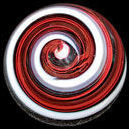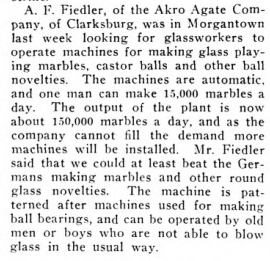-
Posts
463 -
Joined
-
Last visited
Content Type
Profiles
Forums
Gallery
Events
Everything posted by akronmarbles
-
I believe that Albright was the original sole distributor - I have newspaper articles talking about such...memory is a little rusty. I bet Albright was already in bed with Groper prior to CA existing. Albright existed from early 1900's up till recent days - still made industrial marbles in Ravenna up till the 90's.
-
Albright was a manufacturer and a distributor. I found a few CA pieces in Ravenna.
-
Ephemera items are the best! Better than marbles IMHO.
-
October 1927 - "In all six machines are to be operated, and two of these have been installed." References the two DIFFERENT machines mentioned above. Crockery and Glass Journal stated the projected daily output as 300,000 to 350,000 units.
-
Here is some hard evidence - Payne, Ohio. September 3, 1925 - leased building - October 1st- equipment and supplies were arriving. November 12, 1925 - furnaces turned on....... Lots of experimenting.... From February 18, 1926: "The first agates...turned out last week. The agates were fine, of various colors... Several changes were decided upon....correcting..troubles in the color blending tank will be made by Amsler & Morton, glass engineers from Pittsburgh." This article refers to a fully automated process of color mixing and machine feeding...they had some issues to work out.......fast forward to the next year: From March 31, 1927: "H.M. Jenkins, the local manager, has installed new equipment.....large two-pot melting furnace...two working tanks out of which the molten glass is gathered with the use of a long bar or punny(sp) and dropped into the automatic rolling machines......the agate is finally dropped from pocket into a tank where it undergoes...tempering. There are two rolling machines, both invented by Mr. Jenkins, and are the only ones of this kind in existence....the larger one has a capacity of 43 per minute, the other about 16." It seems they ditched the automated process and reverted to the tried and true method of hand gathering. June 9, 1927: "Payne will lose marble factory"
-

What gives us the fire inside of moonies?
akronmarbles replied to Steph's topic in Steph's Study Hall
Tyndall effect caused by colloids in the glass. Calcium phosphate is the most commonly used material to create this glass effect. Lead arsenate will also get you there. Historically this glass is known as girasol. -
Not sure Andrea - I know that Akro sized a 00 at 9/16"....not sure about CA. There are a few in the box that look smaller than the others.
-
-
I am not sure how many vaseline slags MFC created. I know they melted some uranium glass for sure at least once.
-
Vaseline slag fragments and pieces of scrap glass - found inside the former MFC factory building. Left bottom row even contains some oxblood. Made sometime between Sept 12th, 1915 and December 10th, 1917. Barberton Glass Novelty also made melted pontil "vaseline slags".
-
Hope everyone had a good time at my shop.
-
Second article is September, 1917.
-
1919 - "gathering small ware" - I think the workers did whatever they had to do to make the most marbles per hour. I know that the punty rods used at MFC were much longer than 2.5 feet. All of this discussion may relate to a link between similarities in certain Akro marbles and CA's.....
-
I agree on the blending of the glass over time with working John. I saw this with my hand gathered slag making experiments. I am not sure what to make of the "gather" vs "dip". It would certainly be quicker to dip and pull than dip twist and pull (this is how I gather) - but you still need to let the tail of the gather run off which is usually achieved by rotating. This may explain the reason why there are Akro examples with a fine hair like thread wrapped around them - sometimes not even completely melted in. On a side note - Arnold Fiedler was the glass chemist /maker at Akro when this article was published. He may be responsible for the dip method mentioned above - the attached article shows that he was responsible for hiring marble makers and it would not be a hard stretch to think that the methods utilized would be ones
-
Akro Agate: April 1918
-
Anyone have an email address for Ron?
-
The Akron Children's Museum initially wanted to partner with the marble museum but then decided against it. All of the Akron marble artifacts that were on display are now in storage. It is hoped that a new physical space will become available in the near future.
-

Our long Realers thread with the Glassonix discussion
akronmarbles replied to Steph's topic in Archives
Another goodie.... -

Our long Realers thread with the Glassonix discussion
akronmarbles replied to Steph's topic in Archives
This is from 3 September 1927. -
Just measured is - It is larger than I thought - 1.687"
-
Found this at the show. Around 1.5"
-
Right now....







